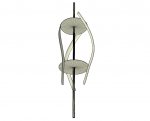Obtaining full scale patterns from a model
I realize that Cheetah is not a architectural modeller but I am wondering if there is a way to obtain full scale patterns from a model. Has anyone tried to print or plot large images in Cheetah? Or will I need to export the file to another program to order to be able to print or plot the sections? Are there any suggestion of what would be the best way to proceed? I have attached an image which shows the 2 tall vertical sections I am interested printing at full scale. These prints would then be used to fabricate the ribs.
Thank you for any help.
Bruce
I realize that Cheetah is not a architectural modeller but I am wondering if there is a way to obtain full scale patterns from a model. Has anyone tried to print or plot large images in Cheetah? Or will I need to export the file to another program to order to be able to print or plot the sections? Are there any suggestion of what would be the best way to proceed? I have attached an image which shows the 2 tall vertical sections I am interested printing at full scale. These prints would then be used to fabricate the ribs.
Thank you for any help.
Bruce



